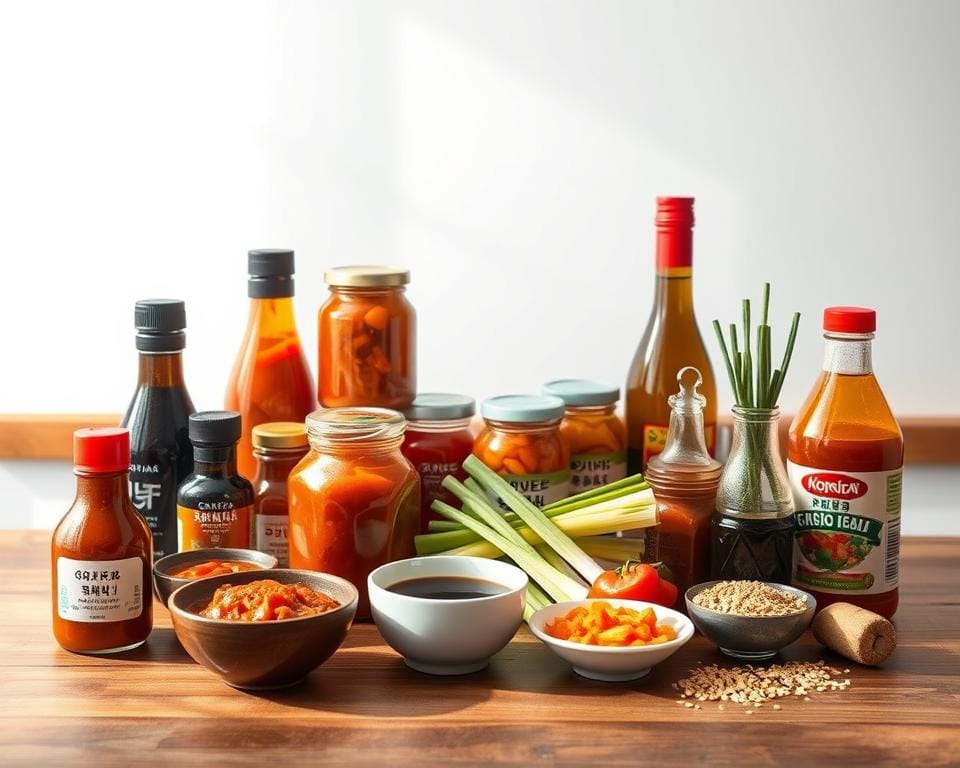Did you know that over 70% of Korean dishes rely on a handful of essential condiments to achieve their signature flavours? These ingredients are the backbone of Korean food, transforming simple meals into culinary masterpieces.
As someone who has explored the vibrant world of Korean cooking, I’ve developed a deep appreciation for these flavour-packed additions. From the tangy kick of gochujang to the umami richness of doenjang, each condiment brings something unique to the table.
In this article, I’ll share my favourite ingredients and how they can elevate your recipes. Whether you’re making kimchi or Korean BBQ, these condiments are a must-have in your pantry. Let’s dive in and discover how to bring authentic Korean flavours into your kitchen!
Understanding Korean Culinary Essentials
The heart of Korean cooking lies in its essential ingredients and techniques. These elements are the building blocks of its rich and diverse flavours. Whether you’re preparing a simple meal or a festive dish, understanding these basics is key to mastering the art of Korean cuisine.
Key Ingredients in Korean Cuisine
At the core of Korean dishes are ingredients like soy sauce, rice, and fermented pastes. Soy sauce, for instance, is more than just a seasoning—it’s a cornerstone of many recipes, adding depth and umami. Rice, on the other hand, is a staple that complements almost every meal, from soups to stir-fries.
Fermented pastes like doenjang and gochujang are equally important. They bring a unique richness and complexity to dishes. These ingredients are not just flavour enhancers; they’re cultural symbols that reflect centuries of tradition.
The Role of Fermentation in Flavour Development
Fermentation is a defining feature of Korean cooking. It transforms simple ingredients into flavour powerhouses. Take doenjang, for example. This fermented soybean paste develops a deep, savoury taste that’s perfect for soups and stews.
Similarly, gochujang, a spicy fermented paste, adds a bold kick to marinades and sauces. The process of fermentation not only enhances flavours but also preserves nutrients, making these ingredients both delicious and wholesome.
By incorporating these essentials into your cooking, you can create dishes that are both authentic and balanced. It’s all about understanding the role each ingredient plays and using them thoughtfully.
Top Korean Condiments to Use in Your Cooking
Exploring the world of Korean cuisine reveals a treasure trove of flavour-packed essentials. These ingredients are the backbone of many dishes, adding depth, heat, and umami to every bite. Whether you’re grilling, marinating, or dipping, these condiments are indispensable.

One of my favourites is gochujang, a spicy fermented paste that brings both heat and sweetness to dishes. It’s perfect for marinating meats or adding a kick to bbq sauces. Its versatility makes it a must-have in any kitchen.
Another essential is soy sauce, which adds a savoury depth to soups, stews, and marinades. Pair it with a touch of salt to balance flavours and enhance the natural taste of ingredients.
Dipping sauces also play a crucial role in Korean meals. They’re not just accompaniments but flavour enhancers that complete the dining experience. From spicy to tangy, these sauces elevate simple dishes into something extraordinary.
- Gochujang: Perfect for marinades and spicy sauces.
- Soy sauce: Adds umami to soups and stews.
- Dipping sauces: Accentuate flavours in every bite.
Proper storage is key to maintaining the freshness of these ingredients. Keep gochujang and other fermented pastes in the fridge, while salt and soy sauce can be stored in a cool, dark place.
From traditional recipes to modern twists, these condiments are the secret behind the irresistible taste of Korean food. Incorporating them into your cooking will bring authentic flavours to your table.
Exploring Unique Korean Sauces and Pastes
The depth of flavour in Korean cuisine often comes from its unique sauces and pastes. These ingredients are the backbone of many dishes, adding layers of taste that are both complex and satisfying. Whether you’re cooking at home or experimenting with new recipes, understanding these essentials can transform your meals.
Gochujang: The Spicy Classic
Gochujang is a staple in many kitchens, known for its spicy kick and subtle sweetness. Made from fermented soybeans, rice, and chilli powder, it’s a versatile ingredient. I love using it in marinades or as a base for dipping sauces. Its rich, bold flavour pairs perfectly with grilled meats or stir-fries.
To balance its heat, I often add a touch of sugar or a drizzle of sesame oil. This not only mellows the spice but also enhances the overall taste. Storing gochujang in the fridge ensures it stays fresh and retains its vibrant flavour.
Doenjang and Ssamjang for Rich, Savoury Notes
Doenjang, a fermented soybean paste, is another essential. Its deep, umami-rich flavour is perfect for soups and stews. I often combine it with a bit of oil and pepper to create a savoury base for dishes.
Ssamjang, a blend of doenjang, gochujang, and other seasonings, is a personal favourite. It’s ideal for wrapping meats in lettuce leaves or as a dipping sauce. Toasting sesame seeds before adding them to ssamjang gives it an extra layer of aroma and crunch.
- Gochujang: Adds heat and sweetness to marinades and sauces.
- Doenjang: Brings umami depth to soups and stews.
- Ssamjang: Perfect for wraps and dips, with a balanced savoury taste.
By mastering these sauces and pastes, you can elevate your cooking with authentic Korean flavours. Experiment with different combinations and find what works best for your palate.
Incorporating Condiments in Everyday Cooking
Adding flavour-packed condiments to everyday meals can transform even the simplest dishes into something extraordinary. Whether you’re whipping up a quick stir-fry or simmering a hearty stew, these ingredients can elevate your cooking with minimal effort.
Enhancing Stir-Fries and Stews
One of my favourite ways to use condiments is in stir-fries. Marinated meat or fresh vegetables take on a whole new dimension when paired with a savoury sauce. For instance, a simple mix of soy sauce, garlic, and a touch of chilli paste can bring out the natural taste of your ingredients.
Stews also benefit from these additions. Letting the flavours develop over time, sometimes even over a year, creates a deeper, more complex taste. A spoonful of fermented paste can add richness and depth to your dish.
Elevating Dips and Marinades
Dips and marinades are another great way to incorporate these condiments. A well-balanced marinade can transform meat, making it tender and flavourful. I often combine gochujang with a bit of honey and sesame oil for a sweet and spicy glaze.
For dips, mixing fermented pastes with a touch of vinegar or citrus creates a tangy accompaniment that enhances every bite. These small additions can make a big difference in your cooking.
- Use marinated meat in stir-fries for quick, flavourful meals.
- Let stews simmer to develop a richer taste over time.
- Experiment with marinades to bring out the best in your ingredients.
With a little planning, even everyday dishes can shine. Focus on balancing flavours to highlight the natural taste of each component, and you’ll create meals that are both delicious and satisfying.
Practical Tips for Using Korean Condiments
Small tweaks in storage and flavour balance can make a big difference in your cooking. Whether you’re a beginner or a seasoned cook, these tips will help you get the most out of your pantry essentials.
Storage and Shelf Life Best Practices
Proper storage is key to maintaining the freshness of your condiments. For fermented pastes like ssamjang, keep them in the fridge to preserve their flavour. Gochugaru, or chilli powder, stays vibrant when stored in the freezer.
Here are some storage tips I swear by:
- Store fermented sauces in airtight containers to prevent contamination.
- Keep noodle dishes fresh by storing sauces separately until ready to use.
- Label containers with dates to track shelf life.
Balancing Flavours with Simplicity
When it comes to korean food, less is often more. I’ve found that using minimal ingredients allows the natural taste of each component to shine. For example, a simple mix of soy sauce, garlic, and a pinch of sugar can elevate any dish.
Here’s my go-to way of balancing flavours:
- Start with a base of fermented paste like ssamjang and adjust with vinegar or citrus for tanginess.
- Use a touch of sweetness, like honey, to balance spicy or salty notes.
- Add fresh herbs or toasted sesame seeds for a finishing touch.
By focusing on these small details, you can create restaurant-quality results at home. Experiment with different combinations and find what works best for your palate.
Building Your Korean Pantry on a Budget
Building a pantry filled with authentic flavours doesn’t have to break the bank. With a bit of planning and some savvy shopping, you can enjoy the rich tastes of korean bbq and other dishes without overspending. Here’s how I’ve managed to stock up on essentials while sticking to a budget.

Where to Shop for Authentic Ingredients
Finding authentic ingredients can be surprisingly easy, even in the UK. I’ve had great success at local Asian supermarkets, which often stock a wide range of products. Online stores are another excellent option, offering everything from kimchi to sesame seeds at competitive prices.
Here are my top tips for shopping smart:
- Visit local Asian markets for fresh and affordable options.
- Compare prices online to find the best deals on staples like sesame oil and kimchi.
- Look for bulk purchases of seeds and spices to save money in the long run.
Selecting Quality Condiments without Overspending
Quality doesn’t always mean expensive. When shopping for condiments, I focus on the type of product and its ingredients. For example, a good sesame seed paste can elevate your dishes without costing a fortune.
Here’s how I choose the best items:
- Check labels for authenticity and avoid products with unnecessary additives.
- Opt for smaller brands that often offer great quality at lower prices.
- Experiment with different types of kimchi to find one that suits your taste and budget.
By focusing on these strategies, you can build a pantry that’s both authentic and affordable. Whether you’re whipping up a quick korean bbq or experimenting with new recipes, these tips will help you get the most out of your budget.
Conclusion
Exploring the vibrant world of Korean flavours has been a journey of discovery for me. From the rich umami of doenjang to the bold heat of gochujang, each condiment plays a vital role in creating authentic dishes. These ingredients, especially fermented soybean products, add depth and complexity to every bite.
I encourage you to experiment with these essentials in your kitchen. Whether you’re preparing a hearty stew or a simple side dish, they can transform your meals. Blending traditional techniques with modern twists allows you to embrace the art of Korean cooking fully.
Don’t hesitate to explore new recipes and enjoy the vibrant flavours of this cuisine. With a bit of creativity, you can bring the essence of Korea to your table. Happy cooking!

